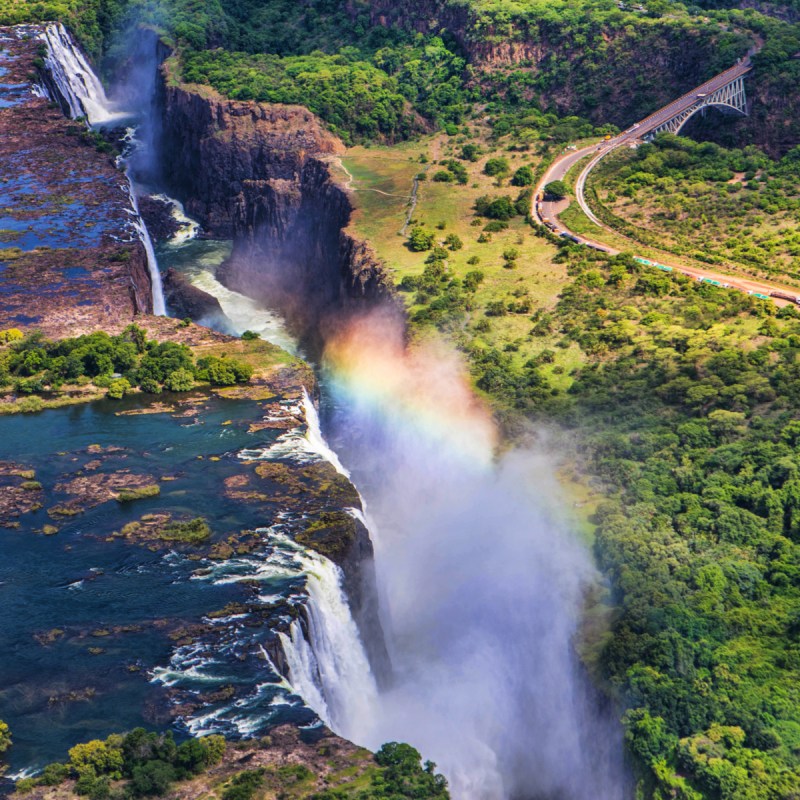
It’s tempting to sum up the differences between Victoria Falls, Zimbabwe, and Livingstone, Zambia, with a few cliches. It’s often said that Victoria Falls is more touristy and Livingstone is more authentic. But when I visited, I found communities that were eager to defy expectations. In “touristy” Victoria Falls, locals sang about politics in the cafes and chatted about economic policy on the drive to the game park. In “authentic” Livingstone, everyone was eager to showcase their sophisticated museums and internationally inspired cuisine. Visitors keen to look beyond the stereotypes will discover warm, welcoming destinations with their own character and plenty to offer.
Videos by TravelAwaits
Here are five key differences between Victoria Falls and Livingstone.
1. The Victoria Falls Experience
First things first: Which country is better for experiencing Victoria Falls? It’s complicated. But the short answer is that the Zimbabwean side, while farther from the falls, affords much better views. In Zambia, you’ll be much closer to the falls — in some cases, you can even stand in the water! — but the views are limited.
Between February and June, the waterfalls run at full force, and visitors should wear rain jackets. Between July and September, you’ll have the best views, since the water is still strong but not nearly as misty. And when the dry season comes in the fall, the views are great and there’s ample opportunity for different water activities.

In Zambia’s Mosi-oa-Tunya National Park, the Victoria Falls World Heritage National Monument Site offers multiple paths for exploring the falls. One of these is the Eastern Cataract, a walk across a footbridge through the mist of the falls. And, for those with plenty of moxie, there’s also the Devil’s Pool — you can read all about it later in this piece. To see the falls, which are about 7 miles from the town center, you’ll need to catch a taxi. You may also need a guide, depending on what you want to see.
On the Zimbabwean side, Victoria Falls National Park has a gift shop, an excellent cafe, local handicrafts, lots of informational panels, and easy walking paths that offer outstanding views of the falls from all angles. I personally like to arrive early in the morning and stroll when things are quiet and the baboons outnumber the visitors. Later in the day, the cafe is the perfect place to cool off and relax before revisiting your favorite trail. The park is located in the heart of Victoria Falls and is set up so that you can easily explore on your own without a guide. Note that if you’re staying outside the main part of town, you might need a taxi to get there.
No matter which side you’re on, if you’re visiting the area during the full moon (or just before or after), ask your hotel about a lunar visit to the falls. It’s an experience you don’t want to miss!

2. The Culture
In Victoria Falls, the tiny Jafuta Heritage Centre within the Elephant’s Walk shopping plaza chronicles the cultural heritage of the Zimbabwean people. It showcases jewelry, traditional costumes, and other artifacts. A plus: It’s located next door to Dean’s Cafe, which uses local coffee beans and is well worth a visit.
Boma in Victoria Falls provides excellent cuisine in addition to a unique cultural experience. You’ll have plenty of opportunities to try local foods (including impala, guinea fowl stew, and crunchy roasted mopane worms) as you enjoy the talents of drummers and dancers.
In Zambia, travelers can visit the Livingstone Museum, the largest and oldest museum in the country. Highlights of its collection include items from the life of David Livingstone, exhibits on modern-day Zambia, a model of an African village, and much more. Admission to this wheelchair-friendly museum costs just $5, an outstanding deal.
Livingstone is also home to the Railway & Gateway Jewish Museum. This hybrid museum chronicles the history of Zambia’s locomotive age as well as the development of Livingstone’s Jewish community. The community traveled to Livingstone in the late 1800s to escape religious persecution in their native Lithuania. They are further remembered in the small Jewish cemetery and synagogue (now a Church of Christ).
3. The Art
Victoria Falls is one of the best destinations for art, handicrafts, and carvings in all of southern Africa. There are gallery-style shops throughout the Elephant’s Walk Shopping and Artist Village and a large curio market out back. Whether you’re looking for a tiny stone hippo that fits in the palm of your hand or an 8-foot wooden giraffe, you’ll find it here.
While Livingstone doesn’t have quite the same art scene, there’s still lots to see. For instance, I found lovely baskets for sale while dining at Golden Leaf (which serves delicious Indian food). You never know where you might find a piece you love. And if you’re crossing the border on foot (something I did four times during my visit!), you’ll encounter craft vendors set up along the way. If you have an assortment of change from Zambia, Zimbabwe, and Botswana, these border vendors will happily accept it.

4. The Wildlife
It’s all but impossible to visit Victoria Falls and Livingstone and not have an outstanding time viewing wildlife.
On the Zambian side, Mosi-oa-Tunya National Park is home to white rhinoceros. A waking safari through Mosi-oa-Tunya is a thrilling opportunity to observe these highly endangered animals in the wild.

In Zimbabwe, Zambezi National Park and Hwange National Park are home to numerous species you can appreciate while on a day safari. While there are no rhinos, you’ll see some of the largest elephant populations in Africa, giraffes, buffalo, birds, antelope, and maybe even some big cats.
One of the most popular ways to see wildlife in the area is to go to another country altogether. Chobe National Park in Botswana is just an hour away. Trips usually cost less than $200 and include a breakfast boat ride, a game drive in Chobe, lunch, and more. You’ll see lions, elephants, buffalo, antelope, and even cheetahs on a typical trip.

5. The Opportunities For Adventure
If you’re a thrill-seeker at heart, you’ll find plenty of adventures on both sides of the border.
Those who love whitewater rafting won’t be able to resist a trip down the Zambezi River, which forms the border between the two countries. Excursions to explore the Class V rapids depart from The Lookout Cafe in Victoria Falls. There are options for those who want to be active participants as well as for those who prefer to be passengers, hanging on for dear life on the adventure of a lifetime!
The Lookout Cafe is also home to the Wild Horizon headquarters, and, in many ways, it’s home base for all kinds of adventure in the region. From the cafe itself you can go zip-lining. The line stretches 1,394 feet across the gorge above the Zambezi, and you can expect to hit speeds of up to 65 miles per hour. There are also flying fox cable slides (imagine running off the side of a cliff and soaring over the gorge like, well, a flying fox) and a gorge swing (a 230-foot free fall before swaying back and forth under a 300-foot arch).
Incidentally, The Lookout Cafe has great breakfast options and makes lovely lattes, which is exactly the kind of thrill I was seeking while I was there. Watching everyone else on the zip lines was just about as much heart-pounding adventure as I could handle!
Despite these incredible adventures on the Zimbabwean side, Zambia might just be the most adventurous destination of all. That’s because Livingstone is the kickoff point for a trip to Devil’s Pool. The forebodingly named attraction is a natural infinity pool at the very edge of the waterfall, and it’s accessible only from the Zambian side. Between August and January, when water levels are low, experienced guides can bring you across the rocks to the pool. You can swim up to the edge and peer over to see the cascading sheet of water falling several hundred feet to the Zambezi below. If your stomach is fluttering a bit at the very thought of doing this, know that you’re not alone. This is definitely not your everyday travel activity!
Pro Tip: If you think there’s even a possibility that you’ll visit both Zambia and Zimbabwe, you should ask for a KAZA visa when you arrive. This visa allows for multiple entries into both countries, which is perfect should you want to walk across the Victoria Falls Bridge or take a day trip. The KAZA visa also permits day trips to Botswana, which is ideal for a short visit to Chobe National Park.
